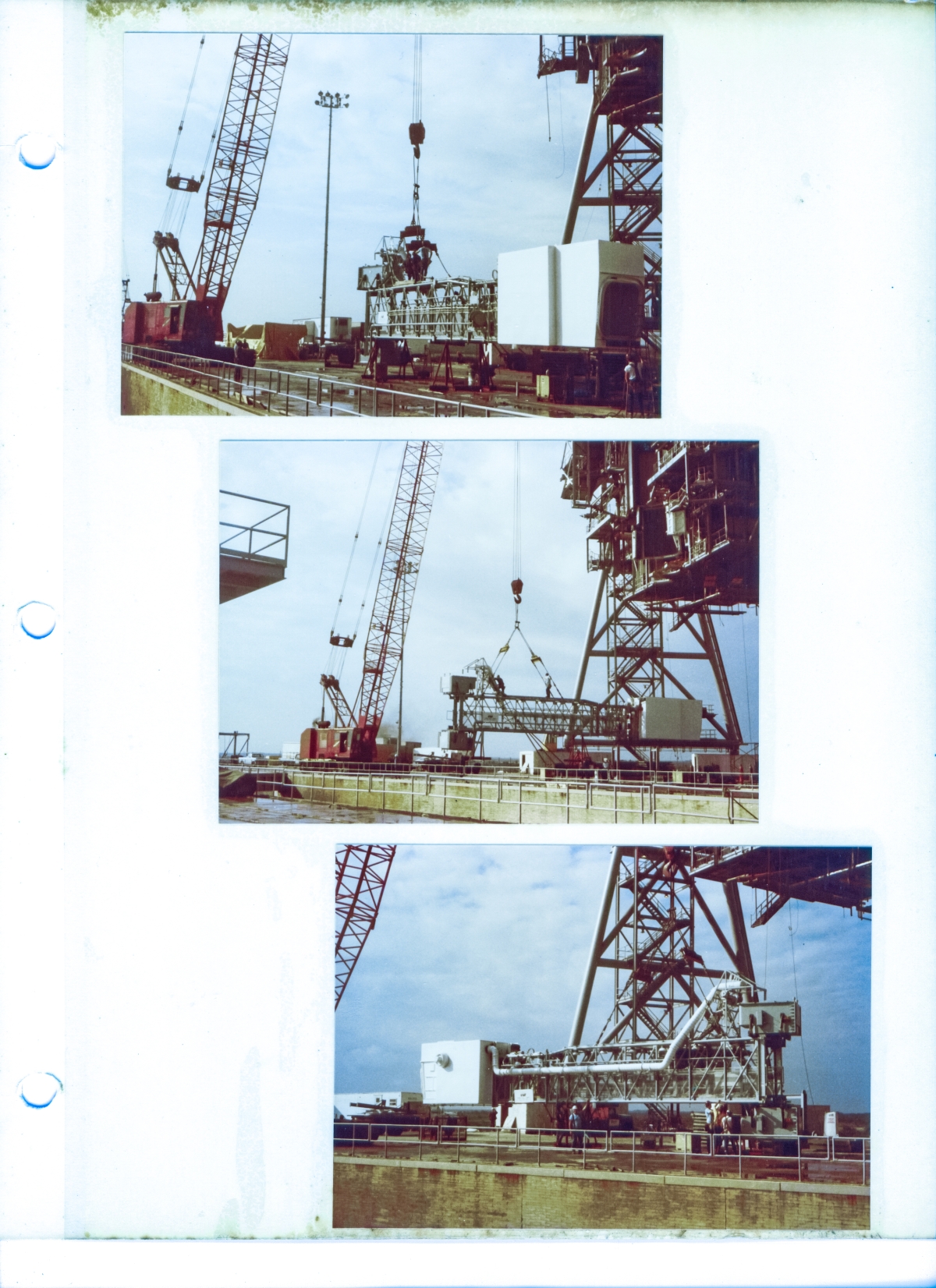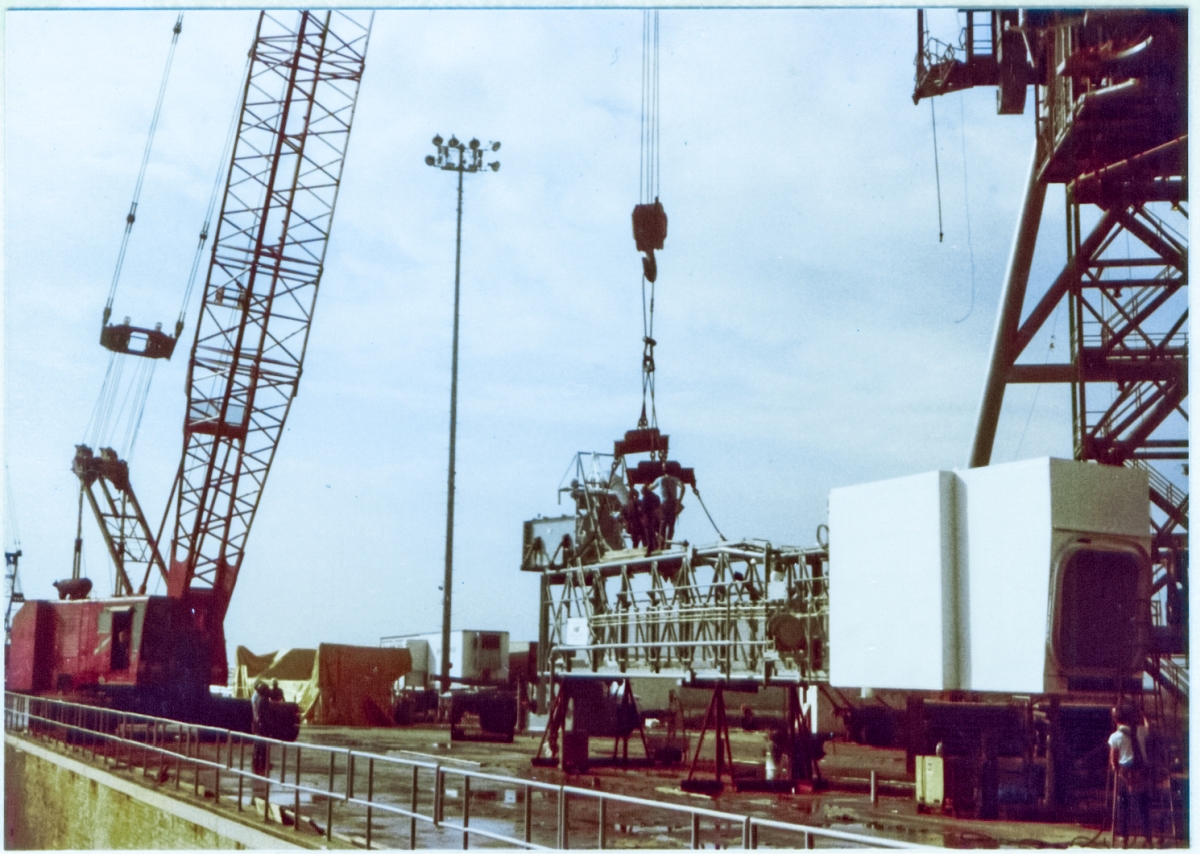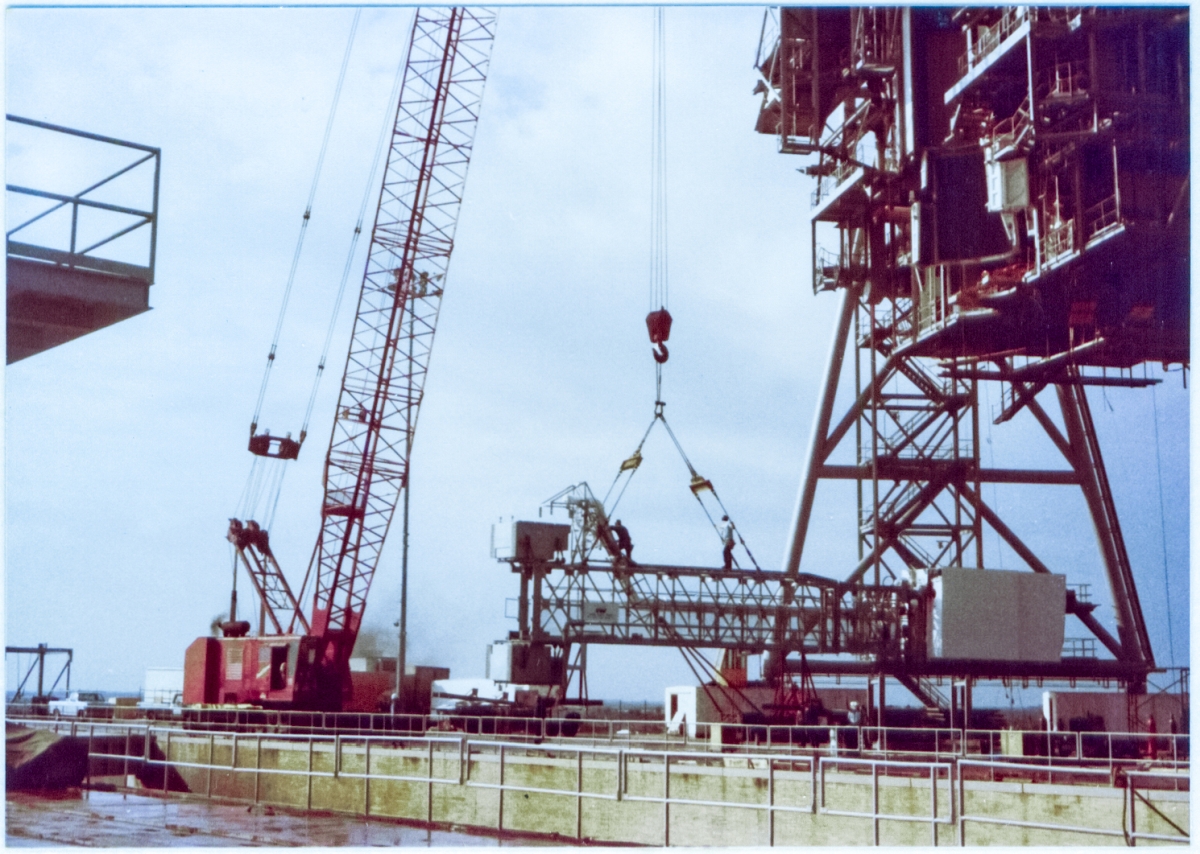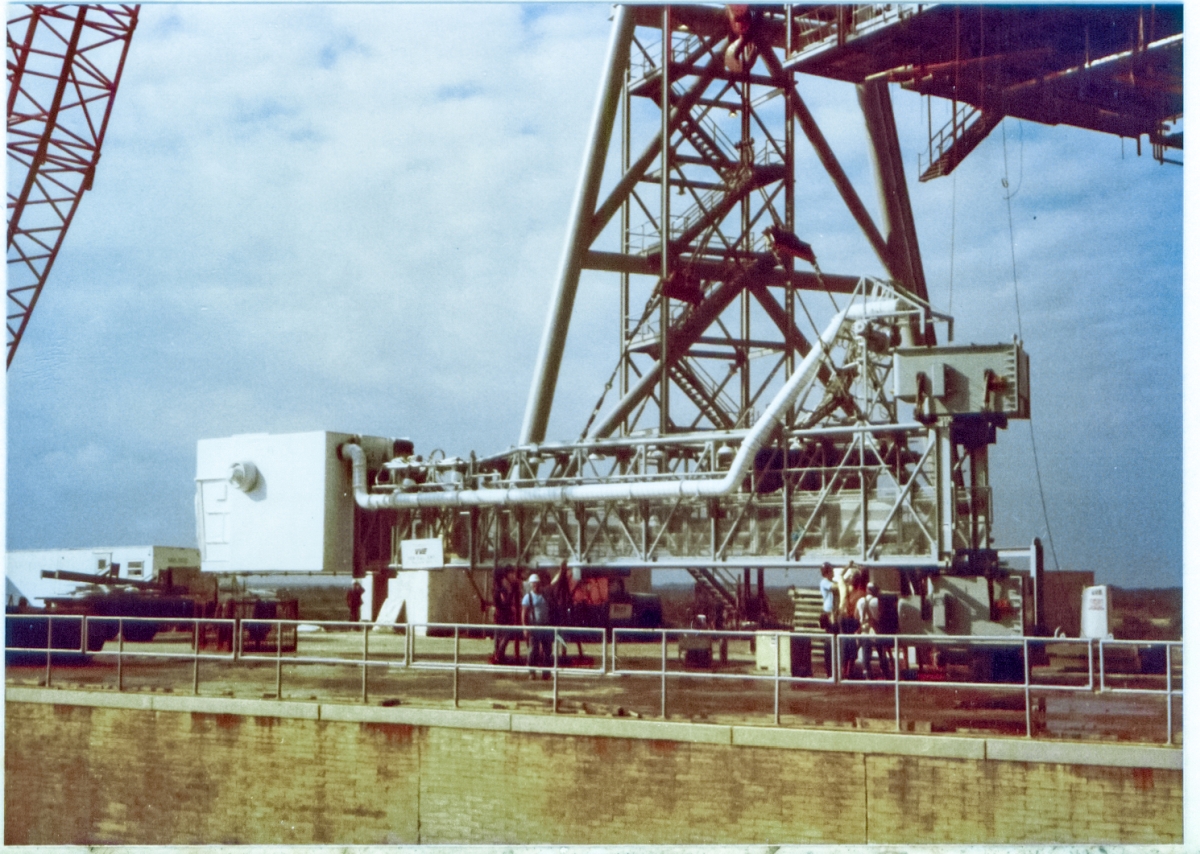Space Shuttle Launch Complex 39-B Construction Photos
Page 21
OAA Lift 1
(Original Scan)
This is the swing arm that the crew walks across from the main structure to enter the Shuttle, and is the last thing that remains attached to the Earth which they will touch, until mission's end. When you walk around on it, and think about that, it can give you a weird feeling.
Additional commentary below the image.

Top:
(Reduced)

Ok, we're about to lift the Orbiter Access Arm, and hang it up on the FSS between the 200' level and the 220' level framing elevations.
The strongback was already in place on the FSS and everything was ready to go.
I've walked across to the far side of the flame trench to get a better angle on things, and the perspective of the view reveals that I've climbed up a bit on something, to get that better angle on things, but I do not recall exactly what. Perhaps the east MLP access stair tower, perhaps something else. I'm not very high up above the pad deck, but I'm definitely not on the pad deck, either. The angle of the shot places me very close to the flame trench, perhaps even directly above it, and that would require me to be on the north piping bridge, but I'm not high enough in the air to be up on the bridge itself. So it's a bit of a mystery to me as to where I'm shooting from in this frame.
And now, returning to these words a year or so later, it occurs to me that maybe I'm not so high above things. That perceived "height" might simply be an artifact of perspective, created by the line of removable handrail which you can see there along the west side of the flame trench. And if I'm not sensibly above things, then it becomes possible for me to be out in the middle of the flame trench somewhere, much closer to that line of handrail than you might at first imagine, and in order to get closer to that line of handrail, there's only one place you can go, and that's out on the crest of the flame deflector itself, stepping gingerly between the spray headers that ran across its full width. This would be a pretty stupid place to be, inviting a stumble and fall, down the impossibly-steep slope of the deflector in either direction, getting chewed all to hell by its stucco-rough surface of Fondu Fyre as you scraped and rolled unstoppably downward for fifty feet before being brought to an abrupt halt with a potentially-lethal bone-breaking thud by the brick-lined bottom of the trench.
Yep. Sounds just about right. Sounds just about like something James Fucking MacLaren would do, just to get a goddamned picture.
I dunno.
Feel free to examine all the other images in this series and try for yourself to figure out exactly where I was shooting from. Like I just said, I dunno.
In the distance, looking remarkably like a gigantic sofa covered in a dingy yellow sheet, the PGHM bridge beam can be seen just to the right of the cab on the Manitowoc, which means these photos were taken before we lifted that monstrosity into place up in the rafters of the PCR.
On top of the arm itself, three ironworkers are getting organized with the lifting gear that attaches to the OAA, and you can see that there's two spreader beams, each with their own slings that attach to the lifting lugs on the framework of the arm.
Notice how close the lift points are to the far end of the arm, please.
This is because the OAA was a pretty light thing in general, (Well..... relatively speaking, anyway. I did a little googling and science.ksc.nasa.gov informs me it weighs "approximately 52,000 pounds" which seems heavy enough I guess, until you compare it with the weight of the RSS which comes in at over five million pounds, according to the Guinness Book of World Records.) with the exception of the two hinges that are partially visible as gray boxes attached to the extreme far end of the arm, and connect to it above and below in a way that gives clear walking access through to the steel bar grating running along the bottom level of the arm truss framing, from the hinges all the way to the White Room on the end of the arm.
The actuator mechanisms inside the hinge boxes were surprisingly massive things, made up of a large number of hefty steel components, and as a result, the center of mass for the whole arm was quite a bit closer to the hinges than outward appearances might give you to believe.
The open "mouth" on the far right end of the white room was the opening which the crew of astronauts would pass through, directly abutting the open entrance hatch on the side of the Space Shuttle, as they boarded their vehicle on launch day.
The arm remained retracted, extending south from its attach location on the FSS, secured to its latchback, out of the way, until the Shuttle had been rolled out to the pad, at which time it was swung around into position, inches away from the left side of the orbiter, and the perimeter gap between the opening in the arm and the exterior surface of the orbiter was filled by a set of inflatable seals which you can see (deflated) in this image, that ran around the opening in the end of the white room. Filtered air was pumped into the white room while it was in use, to eliminate the chance for contaminants entering the Space Shuttle, possibly fucking something up, with, of course, potentially dire consequences, should such a thing be allowed to happen. Once the bird was on the pad, this was the one and only way for technicians and flight crew to enter or exit the Crew Compartment.
The OAA was a Big Deal and was treated as such at all times.
Middle:
(Reduced)

Ok, now we're underway.
The Manitowoc belches a dark cloud of diesel exhaust, the arm comes up off of the pad deck along with its support stanchions which will not be removed until the lift is underway for real, and a couple of ironworkers remain on top, making damn good and sure that the arm is well-leveled, and every last bit of the lifting gear is where it belongs and is doing what it's supposed to be doing, safely and securely.
Like I just said, the OAA was a Big Deal.
In this view, you get a pretty good look at the overall layout of the arm, and can plainly see that the lifting slings are offset substantially toward the heavy, hinge end, of the arm.
On the ground, the guys on the tag lines swing the arm around into its lift orientation, and everything is getting its final going-over prior to things heading up into the sky.
Bottom:
(Reduced)

Final checks and preparations just about complete, now.
Everyone's happy with the lifting gear, and our ironworkers have come down off of the top of the arm.
Near the center of the arm, wearing a white hard hat and blue t-shirt, ever-present suspenders holding his trousers up beneath his outsize belly, Harvey Dixon gives a theatrically-big wave and appears to be momentarily considering me askance with his usual mixture of amusement and contempt.
Behind Harvey, the arm hangs, as if on display in a museum.
The duct that furnishes air which has been filtered and pre-conditioned for the white room runs along the full length of the truss, and can be seen clearly, running from above the top hinge, all the way to the other end where it enters the white room. On the side of the white room, the exhaust vent for that air can also be seen clearly, as a round button-looking object, casting a shadow against the white background of the room itself.
In the background directly behind the OAA, looming complexly, the large structural pipes of Column Line 7, along with its emergency egress stair tower, can be seen in semi-silhouette against the alto layer of clouds in the sky.
Column Line 7 holds up the entire weight of the RSS and all that's welded and bolted to it over on its side of things, and is a substantial entity, in its own right.
That stair tower afforded a marvelously unobstructed and long-range view of things from northwest to southeast of the pad, over in the general direction of the SLF, the VAB, the KSC Industrial Area, mile after lonesome mile of fearsome rough-country swamp, the Titan-III ITL facilities, Pad A, and everything else over in that direction.
I visited the stair tower on Column Line 7 every goddamned chance I got, and still marvel at my astoundingly, undeservedly, good luck that I was able to do so, to this day.
Nobody ever used that stair tower for anything, and I always loved to get out there on it at some intermediate level between the pad deck and the 135' bottom truss level of the RSS, and bathe myself in the splendid isolation and gorgeous view. And maybe pinch myself every once in a while, fearful that I might suddenly come bolt-awake only to discover the miracle-at-hand was only a dream.
Return to 16streets.comACRONYMS LOOK-UP PAGEMaybe try to email me? |